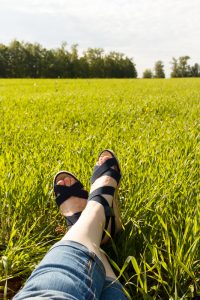Are Sandals Bad for Your Feet? Maybe, Maybe Not
The case against wearing sandals is strong, but not a slam dunk. Are sandals bad for your feet? Here are both sides of the sandal (and flip-flop) discussion.
Sandals, once considered summer and beach footwear, are now a year-round business. They passed the $7 billion mark in U.S. sales a decade ago, and that doesn’t even include flipflops. THey’re popular for a reason—actually several reasons. They’re light-weight, comfortable, cool, easy to get on and off, relatively inexpensive, and sometimes stylish. But… are sandals bad for your feet?
Why Sandals May be Bad for Your Feet
According to at least some experts, sandals may not be good for your feet. They don’t absorb shock, they have little or no arch support, and they provide even less lateral (side-to-side) support. Sandals offer close to zero protection from objects at ground level, and they’re terrible for jogging, running, or playing a sport.
Flip-flops may be worse. According to Piedmont Health in Atlanta, flip-flops provide no support, which is a leading cause of plantar fasciitis and Achilles tendinitis. Thong flip-flops can cause hammertoe as the toes constantly struggle to hold the foot in the shoe.

Are sandals bad for your feet? There are two sides to this debate.
Another Take: “Are Sandals Bad for Your Feet?”
So is the case closed against sandals and flip-flops? Not according to Stephen Pribut, DPM, FACFAS, Clinical Assistant Professor of Surgery at George Washington University School of Medicine. “If you have no pain in your feet and lower legs, and are comfortable wearing sandals, there is no reason not to wear them,” Dr. Pribut says. “But if you are having pain from plantar fasciitis, Achilles tendinitis, shin splints, or other conditions, sandals and flip-flops are not likely to be the best footwear.”
What to Look For in Sandals
Dr. Pribut, a past President of the American Academy of Podiatric Sports Medicine, adds that sandals with a molded arch and straps that keep your foot attached to the surface of the sandal are better than the flat and flimsy type of sandal.
For flip-flops, he recommends those designed with a bit of an arch, a sole that is somewhat stiff and can’t be rolled up into a ball, and straps that go further back on the feet so your heel doesn’t lift up too much.
“I like the foot and footwear to work together as an integral unit,” Dr. Pribut explains. “When the foot and shoe stay in close proximity to each other rather than separating and moving in different directions, they function as a single working unit. This way the shoe can offer the best protection, support, and cushioning possible.”
What About Wedge Sandals
Wedge sandals (wedges) have a stiffer and thicker sole than flat sandals. Dr. Alex Cor, DPM, a Milwaukee-based spokesperson for the American Podiatric Medical Association (AMPA), warns that a (closed-toe) wedge sandal might cause pain at night when the foot stretches back to its normal length. He recommends that women choose wedges with heels no higher than 2 inches. He also suggests taking time to stretch your feet after wearing wedge sandals.
Look for the Seal
If you’re not sure about the safety or design of sandals, look for the APMA Seal of Acceptance. The seal is granted to products (shoes, socks, insoles, materials, and equipment) that promote good foot health.
The Bottom Line
If your feet don’t hurt when, or after, wearing sandals or flip-flops, you’re okay. If they do hurt, your footwear is not helping. Think again about what you have on your feet, whether it’s sandals, flip-flops, or any other type of footwear.


 Vestibular Migraine Diet
Vestibular Migraine Diet  Bone Spurs on the Spine
Bone Spurs on the Spine  Knee Injections for Osteoarthritis Pain Relief
Knee Injections for Osteoarthritis Pain Relief 
They don't offer the support that we get from legions of other shoe and sneaker types, so are sandals bad for your feet? Not necessarily...
© Mercedes Maldonado | Dreamstime.com